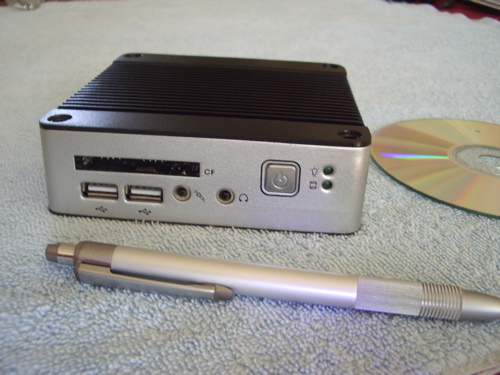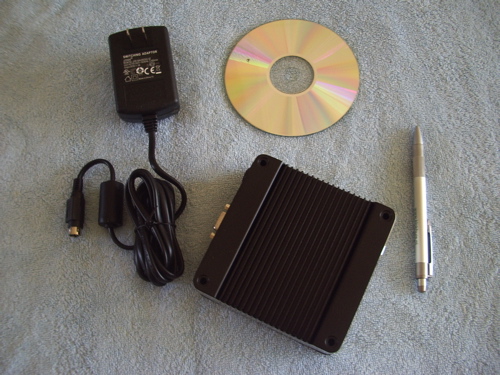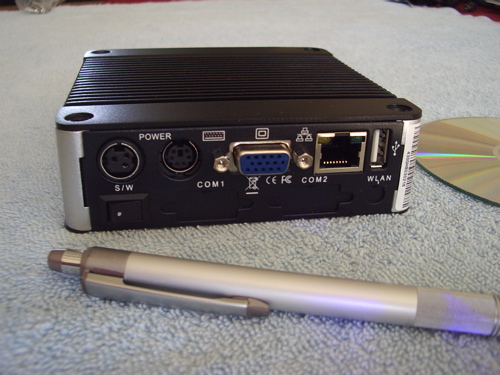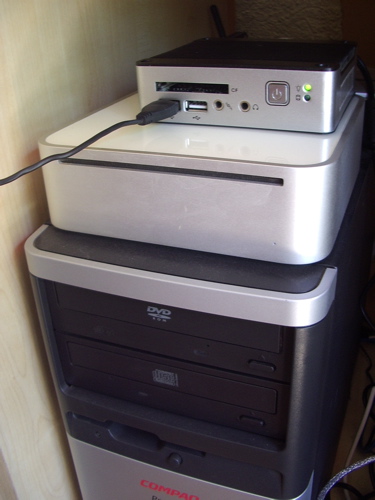 The web is a fast medium: before you know it you’re surfing off to other shores. So let me get the message out straight away: if you have a tight budget, love our planet, and need a computer, then put the Norhtec MicroClient Sr at the top of your shortlist! This is the smallest computer I have seen until now, and can be used in many situations to replace the larger and heavier computer system. If you are starting with a clean slate, even better: definitely consider this tiny powerhouse! It’s a small computer in physical size, uses a lot less energy. BUT let its Puppy Size not deceive you: there’s a lot of power inside to address your (personal) computing and communication needs.
The web is a fast medium: before you know it you’re surfing off to other shores. So let me get the message out straight away: if you have a tight budget, love our planet, and need a computer, then put the Norhtec MicroClient Sr at the top of your shortlist! This is the smallest computer I have seen until now, and can be used in many situations to replace the larger and heavier computer system. If you are starting with a clean slate, even better: definitely consider this tiny powerhouse! It’s a small computer in physical size, uses a lot less energy. BUT let its Puppy Size not deceive you: there’s a lot of power inside to address your (personal) computing and communication needs.
It’ll save you money, and you’ll do your share in “every watt counts”. Of course economy lies in numbers: if you are deciding on tens, hundreds or even thousands of units – now that’ll start adding up! I feel this product is by no means the end of the road: it’s a great working prototype on the way to smaller, and less power consuming devices. The next generation goal: not 10 watts but 1 watt for the same computing power! Just can’t wait to see that kind of products hitting the market…. but for the time being, in my “digital communication laboratory” I now have very valuable tool! Writing this in 2008 AD: I’m quite happy with the progress that CAN be made IF this technology would be adopted on a large scale! Some interesting starting points on this subject: TBL and Green Computing. Out here I’m not only looking into the theory, but also getting some hands-on experience. And I can now tell you: it really works…
Sure hope I got your attention, and I would like you to read how I came to this loud and clear conclusion…
A bit of History
Let me start at a beginning and answer these questions: from what perspective do I operate, and what was the situation before I started installing the MicroClient SR? By the way: if I’d start at THE beginning of my story, it would become an entire novel… so I’ll not do that here 😉
My interest is with personal computing & digital communication: the computer as a tool, a means to an end. Compare it with a car: I like to drive, I’m not a mechanic. So you’ll not find much technical jargon in my review – at least no unnecessary difficult words. I like to keep it simple, and find ways to explain complex concepts in words the rest of us understand! For the technical reader: there are many places on the web, where you can find more information than you’ll ever need. Here I will tell you how I took this little machine for a test drive, what I found out about it from the (end)user’s point of view.
So I “test drive” different pc’s, and look for innovation in software. That’s why about four years ago I installed a Compaq (Windows XP, and Linux) and a Mac Mini (MacOSX) connected to one set of keyboard, mouse, and flat screen. With a switch from A to B and back I could work on the desktop of my choice of the moment. If I got you lost: compare it to driving different cars, with different kinds of fuel, like gasoline, diesel, or lpg. Still looking for the “fuel cell car” on the road 😉
About three years ago we were lucky to get a permanent connection to the internet, and I switched on my Mac Mini 24/7 to work as a desktop, and a personal server (in that way I could reach my information from anywhere – for instance from the internet caffee while on holiday) I chose the Mac Mini, because it was the smallest unit I could find at the time, and it takes about 30 watts, as opposed top the tower unit with some 100 watts.
Of course I have been on the look out for a unit using less energy, because or electricity bill is way too high! And now is the moment: I get a chance to meet the Norhtec MicroClient SR. I’m quite excited to see what it can do…
Time for a Change
When the little unit arrived I couldn’t wait to install it, but as it turned out I had to have some patience. As you can see on the picture, the power adaptor has two flat pins. In the Netherlands we have two round ones, so I bought a conversion plug. The shopkeeper told me, it is the only model available here. So I had to cut off the edge with a little saw to make it fit. It was a minor challenge, and it was fun. But it would be nice of Mr Norhtec if one could order the right plug straight way… As it is now: check your local situation! And yes… on the plus side: the adapter covers 110 to 240 Volts.
Once I saw the powerlight my first trials were disappointing because I couldn’t get the unit to work. In the package there was no clear indication what components were inside, nor if and what operating system is pre-installed. And I didn’t have a clue at that point what a CF was. It has a hard drive indicator, below the on/off indicator. So I assumed a drive inside… and expected it to be plug and play. It turned out to be plug ‘n pray, with no clear “quick start guide”. The documentation in pdf format, being very technical about the hardware, gave me no clues except to open up the unit and see for myself if there is a hard drive inside. Nope… so I’ll have to find something else to get it going!
Now at such times I feel like a newbie all over again: someone looking at new equipment, and software for the first time. In a sense that is true: but then I feel I’ve become “an experienced newbie” by now. The world is a big place, and new technologies are thrown at us at an enormous rate. So keeping up with everything is a full time job. I missed out what a CF is?! Can anyone blame me for that? This time around, I learned a lot in a few days… What’s my occupation? I’m an experienced newbie… 😉
So looking back the only negative thing I can say about my experience so far, is the complete lack of a simple end user “quick start guide”. As it turns out, I feel this is high quality equipment, which is – probably – mostly shipped to computer experts who know their stuff, and the ins and outs of hardware and software. With this review I’ll attempt to change that: I’ll include a tutorial on how I set it up! So if you read on, you can learn the easy way… and your setup should be a smooth sail.


Puppy Linux and USB Flash Drive
During the last three years I have been experimenting with Puppy Linux, and find that with every new version it becomes better. In my view the current version 4 works nicer than the other big Linux flavors I have tried (Ubuntu, Suse, RedHat/Fedora), and it now rivals the big popular commercial operating systems on the market! In some respects it is the best around: a complete, modern system in less then 100 Mb… Hey, big Giga Brothers: this little Puppy from Western Australia is starting to bark like a grown up dog 😉
I had read about Puppy Linux (and some other flavors) on a USB stick. So I wrote an email to the manufacturer asking if this is possible with the MicroClient Sr. Although they were very responsive, they gave me no clear “yes” or “no”. Judging from what I read on the web I thought it would be worth trying: I had this 4 gb USB stick lying around anyway (which had cost me about 30 us$ at the time – they’re a bit cheaper these days). The instructions on PendriveLinux.com were very encouraging, and as it turned out: if you can re-install Windows on your computer, installing Puppy Linux on a usb stick is much easier. So ease of use is no more an excuse to stay with the Big Dog… this Little Puppy is eager to learn some tricks 😉
Energy Consumption
To confirm the amount of energy used by the different components, I put an energy meter in the socket where all the equipment draws its electricity. The router, and the phones take up a constant 10 watts: they have to be on if we want our phones to work. Turning on the Mac Mini brings it to some 40 watts, with bursts up to 90 watts with extra hard disk activities – so the average use of the Mac Mini I estimate between 35 and 40 watts. Then I have a switch that turns the monitor on and off. I was surprised to see this little 15 inch flat screen takes 60 watts in use, and 40 when on standby.
Turning on the Compaq tower it burns some 100 watts with bursts to 180 with disk activities: so there you have an average of 110 to 120 watts. That’s some three times that of the Mac Mini.
Switching off all the equipment (except for the router and the phones of course), I installed the newly arrived MicroClient Sr. When I switch it on the combination draws 19 watts, with some peaks going to 24. So the estimate is on 10 watts for this tiny unit, which has no hard drive nor fans: it can work entirely off a usb-flash.
Some Calculations
Let’s do some calculations to see what I will be saving compared to the Mac Mini setup I had. I’ll not exaggerate it, so it should be even better. Say I save 20 watts (it’s more like 30 watts), that makes: 0,02 kW x 24 hrs x 365 days = 175 kwh/year x 0,25 euro = 43 euro x 1,5 us$ = 65 us$
Did you get that? I am going to save an estimated 65 US dollars per year on energy, as compared to the Mac Mini.
The setup comes to:
MicroClient Sr $195
Shipping $45
USB 4Gb $20
Donation to Puppy Linux $10
Making it a total: $270
So compared to the Mac-Mini the break-even point 270/65 = 4,15 = just over 4 years. Although I wasn’t able to obtain information on the expected life of the unit, my educated guess is: with quality – and no mechanical – components it should live at least 8 years?!
If I make the comparison with the average tower unit: let’s be very conservative and say it saves 70 Watts.
0,07 kW x 24 hrs x 365 days = 613 kwh/year x 0,25 euro = 153 euro x 1,5 us$ = 230 us$/year
270/230 = 1,2 years
So compared to your average tower unit: after little over a year the savings on energy costs will have earned back the investment. This is assuming you keep the unit on 24/7 as a personal server, of course. You could make some calculations estimating the hours per year you have your unit switched on, to see what it’s like for you.
Of course the “mileage” will vary with local situations, but it gives you an indication! If the above sounds all Double Dutch to you, don’t worry: in plain English I would say that the MicroClient Sr uses a third of the power consumption compared to the Mac Mini, and only one tenth compared to the average tower unit. And in my situation the little unit is just as responsive / works just as fast – if not slightly faster. Having the little Norhtec machine switched on, and the other two switched off…. just feels right…. don’t worry: I’ll put the “big” machines to good use still!
And by the way: don’t look down upon my “home grown laboratory”; many new ideas were thought out in the living room or in a garage!!! And yes: very limited research budgets, make very creative…… with legal software!!!
 Why the Senior?
Why the Senior?
Why did I the choose the MicroClient Sr and not the Jr version? If I would only use the machine as a client: browsing the internet, doing some wordprocessing, making calculations in a spreadsheet – the “normal office work” – the Junior with 128 Mb RAM would have been quite sufficient. In my situation though I can use the 512 MB RAM in the Sr: besides the normal office work I want to run three instances of Comswiki (= personal server) so I can use my wikis all the time from everywhere. You wonder: what is Comswiki? Here you may find some answers!
My Cookbook
After telling you some background on how, and why I got the MicroClient Sr in good working order, you can get a head start with this cookbook. What you will need:
-
working PC with Windows/Linux, with a cd burner and a free usb slot
-
cd burning software
-
empty cd
-
usb flashdrive preferably 2 to 4 Gigabyte
-
a switch box and cabling to connect your new computer to the same keyboard, screen, and mouse (or just replace your old with the little new machine!)
-
enough money on your bank account (or a kind donation from someone who has!)
-
an ounce of patience
-
a pinch of an adventurous spirit – because you’ll leave the trodden path :-)!
-
and being happy to learn something new
Your recipe may be a bit different, depending on your starting point and your budget: if you have the extra us$ 50 you can order a Compact Flash drive with a Software System pre-installed. Which makes it very easy: just plug it in, and off you go!
I feel the recipe below is much more fun though, adding some spice to your life:
- go to the Norhtec Website , and order the MicroClient Sr when you’re ready
While waiting for the unit to arrive:
- Get to know Puppy Linux
- Download the ISO and burn the cd
- Take your new liveCD for a spin, and fall in love with a Puppy that is starting to bark like a big dog 😉
- Use the Universal installer to put your Digital Puppy on a USB Flashdrive
Add your personal software. You could try this:
Join a community of MicroClient owners, to ask your questions: MicroClient Google Group
… and once you know help out others 🙂
When your unit arrives, you’ll be ready to get it going in no time…
Conclusions
At the start of my review I already gave you my clear advice: do your bank account, and our planet a favor and go for this little powerhouse. If your experience will be like mine your ride won’t be without wrinkles, but it will be fun and very rewarding. You’ll teach your Puppy some tricks, and it’ll teach you new ways of doing things! And you’ll find out, that this little creature is starting to bark like a grown up dog! Of course my setup has now only been running for a week, but I am already confident that in time my Puppy Love will become a mature mutual trust and friendship for life…


